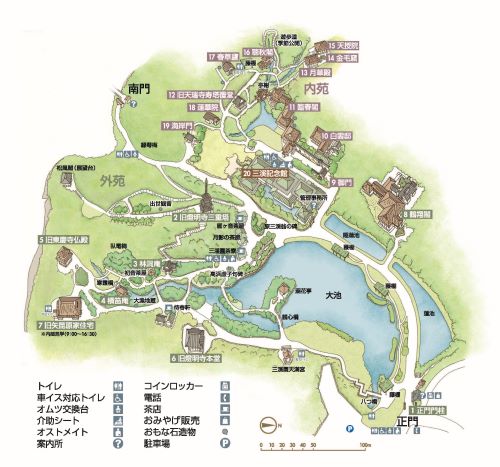- Yokohama-shi Top Page
- Municipal Government Information
- Public Relations, Public Relations, and Public Relations
- Public Relations and Publications
- Public Relations Printed Materials
- Public information Yokohama
- Public information Yokohama-shi version
- Discover Yokohama Aya
- November 2023 issue Old and new Japanese culture Wonderland-Sankeien Garden
The text is from here.
November 2023 issue Old and new Japanese culture Wonderland-Sankeien Garden
Yokohama with sea, port, greenery, history, region, people and various attractions. We will deliver the color of this city as "Yokohama Aya Discovery". This time from Sankeien in Naka Ward.
Last updated on December 1, 2023.
Please see the link for the contents of the "Public Information Yokohama" November 2023 issue "Yokohama Aya Discovery". .
Wonderland, an old and new Japanese culture
Nobuko Nakamura, a scholar of Sankeien Hoshokai, a public interest incorporated foundation
Sankeien was built by Hara Sankei (real name: Tomi Taro 1868-1939), a businessman who made a fortune in raw silk trade. An old architecture was relocated from Kyoto and Kamakura to create a garden in Honmoku, which was inherited from the previous generation. Opened in 1906 (Meiji 39) and opened to the public. The scenery created by skillfully utilizing the terrain of the valley called "Minoya" can be said to be the sense of Sankei, who is familiar with art.
The scenic Honmoku, which also became the subject of Ukiyo-e.
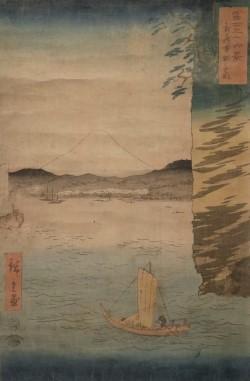
Hiroshige Utagawa "Fuji 36 Views Musashi Honmoku no Hana" (consigned by Sankeien)
Sankeien began around 1887 (Meiji 20) when the predecessor Zenzaburo set up a villa "Matsukakaku" in Honmoku. It is said that Zenzaburo decided to purchase this land was the ukiyo-e of the Edo period, Hiroshige Utagawa, "Fuji 36 Views Musashi Honmoku no Hana". In front of Mount Fuji, I think it represents Isogo no Hama and Umebayashi Sugita, which has been known since the Edo period, so you can see the white and pink bands slightly.
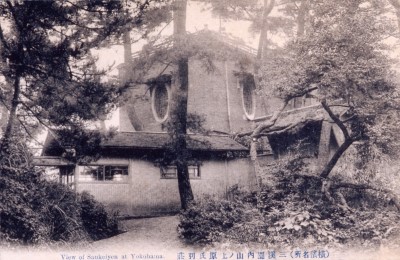
Picture postcard "(Yokohama famous place) Sankeien Uchiyama no Uehara villa" (Sankeien possession)
It is said that the Shofukaku was built on a mountain near the coast with a good view, and its name was given by Ito Hirobumi. Unfortunately, it was destroyed by the Great Kanto Earthquake of 1923 (Daisho 12), but from the observation deck built on the site, you can still enjoy Fuji in the seascape.
Sankei's garden structure
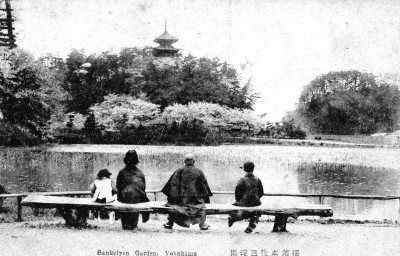
Postcard "Yokohama Honmoku Sankeien" (collected by Sankeien)
In place of Zenzaburo, who passed away in 1899 (Meiji 32), Sankei, who succeeded the family business of the Hara family, purchased land, reclaimed fields and wetlands from around 1902 (Meiji 35), and focused on the creation of Sankeien. I will continue.
The gardening of Sankei is because it raises gardeners. A letter to Jinkichi Imamura, an antique dealer in front of Horyuji Temple, where we had a close exchange, sent gardener Kamekichi Ebisawa to Nara, Mt. Koya-san, and Kyoto to take care of garden research. It is written that I requested it. I used to refer to famous places and historic sites in Nara and Kyoto for the landscaping of Sankeien. What is particularly noteworthy is that it emphasizes that you want to show the scenery of Nara overlooking the tower and Mt. Mikasa from a certain point. You can imagine the relationship with the view of three-storied pagoda over the pond, which is a typical landscape of Sankeien Garden.
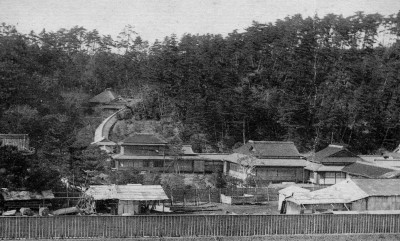
The inner garden (collected by Sankeien) under construction around 1922 (Daisho 11)
The old buildings scattered on the grounds, including the three-storied pagoda, were relocated from Kamakura and Kyoto, and can be said to be the cornerstone of the garden landscape. As can be seen in the example of the former Tenzuji Suto Cover Hall, which was handed over from Daitoku-ji Temple in Kyoto, Sankei took over what was no longer able to be maintained by the owner, repaired it carefully, and relocated it to Sankeien.
The thoughtful Sankei is also cautious about deciding where to relocate. The relocation of the Rinshunkaku, which was obtained in 1906 (Meiji 39), took seven years, in 1913 (Daisho 4). The reason for the step was that the location of three-storied pagoda, which was relocated from the former Tomyoji Temple in the previous year, was fixed on the mountain. At this time, Sankei showed his commitment to changing the layout of the building and relocating it in consideration of the location where three-storied pagoda could be seen from the interior of the Rinshukaku.
The inner garden area, which Sankei called "the other half of the essence", was completed in 1922 (Daisho 11) with the completion of the relocation of Koshukaku. The gardening, which began at the age of 34, has been over 20 years, and when we saw the completed form, Sankei was 54 years old. In 1923 (Daisho 12), a Daishikai tea ceremony was held brilliantly with the completion of the entire Sankeien garden. 18 seats were set up throughout the park, and it was full of many people who were familiar with the tea ceremony.
Beauty inherited over time

The inner garden and colored leaves
After 100 years, Sankeien has a total of 17 buildings, including 10 important cultural properties and 3 Tangible Cultural Property designated by Yokohama City, and the garden itself is designated as a national scenic spot. In a garden that changes the taste of each season, the old architecture that has been handed down over time stands, and it is a beauty that can be compared to a wide painting.
Looking back on the history of Yokohama, it can be said that the opening of Yokohama Port in 1859 (Ansei 6) was an event with a great impact. In Yokohama, which played a central role in modern Japan, Sankei's desire to protect and convey Japanese culture and history while Western culture is respected. And Sankeien, created by the aesthetic sense that he himself loves calligraphy, is an old and new Japanese culture Wonderland. We look forward to your visit today, as it was 100 years ago.
Autumn leaves light up!
You can enjoy a stroll through the garden even more gorgeously with the light-up. Please come and take this opportunity.
Date and time
Limited to Friday, Saturdays, Sundays and holidays from November 23, 2023 (Reiwa 5) to Sunday, December 10 (Thursday / holiday)
Sunset ~ 19:30 (final admission 19:00) ※The viewing range will be restricted from 16:30.
Fees
Free of charge (excluding admission fee)
Map in the park
Sankeien Garden is a vast Japanese garden with an area of 175,000 m2. On the official website (outside site), you can browse and download the map (outside site) above, and also recommend walking courses (outside site) are posted. At the same time, you can also check the opening hours, admission fees (outside site), traffic access (outside site), etc.
Not Available Reader present
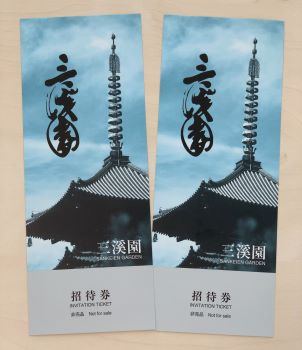
The application has been closed, and prizes have been sent to the winners on Friday, December 1st. Thank you very much for your application.
Thank you for always seeing "Public Information Yokohama" and "Yokohama Aya Discovery". We will present a Sankeien admission invitation ticket to 5 sets of 10 people by lottery from those who have received their impressions. If you wish, please refer to the following six items. ※Please specify and apply by postcard (to Yokohama City Hall Policy Bureau Public Relations Section, 6-50-10 Honcho, Naka-ku, Yokohama 231-0005) or e-mail ([email protected]). The deadline must arrive on Thursday, November 30, 2023.
※ 1.Postal code, 2. Address, 3. Name, 4. Impression, 5. I would like to read, 6. "I wish to present the November issue"
The winner's announcement will be returned by sending the prize. In addition, the personal information you receive will not be used for any purpose other than sending prizes.
Contact Yokohama City Hall Policy Bureau Public Relations Section TEL: 045‐671-2331 FAX: 045‐661-2351
Inquiries to this page
Phone: 045-621-0634
Phone: 045-621-0634
Fax: 045-621-6343
Page ID: 355-619-055


